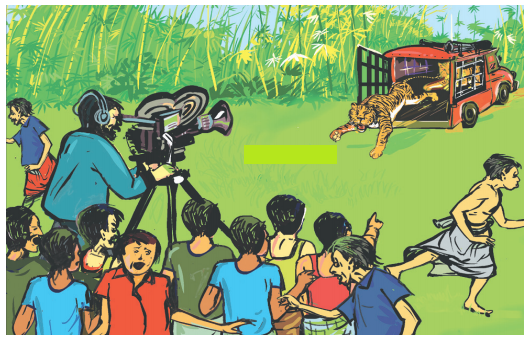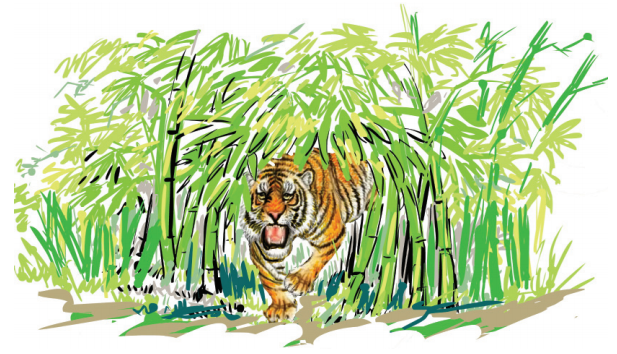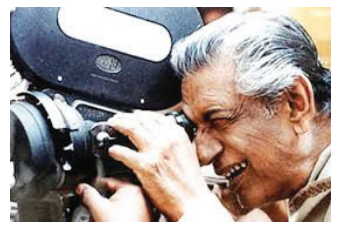“Project Tiger Summary” is a blog article that provides a comprehensive overview of the famous conservation initiative known as Project Tiger. This article aims to give readers a concise yet informative summary of the project, highlighting its objectives, key milestones, and impact on tiger conservation in India. By delving into the history and significance of Project Tiger, this article aims to raise awareness about the importance of protecting these majestic creatures and the efforts undertaken to ensure their survival. Read More Class 10 English Summaries.
Project Tiger Summary
Project Tiger Summary in English
Page – 43
1. No one can beat Hollywood when it comes to making films with animals in them. I remember many such films in which there was an Alsatian named Rin-tin- tin. It acted even better than humans. Later there were some films with a collie called Lassie. It looked as if the director could make Lassie act the way he wanted it to act. These dogs were like stars and they were paid like any other big actor. Their owners could easily get one lakh rupees from just one film.
2. I saw how these animal actors were reverently treated when I went to the Disney Studio in Hollywood. The main character in this particular film was a large dog. When I went to the studio, the shooting had not started.
Page – 43
1. No one can beat Hollywood when it comes to making films with animals in them. I remember many such films in which there was an Alsatian named Rin-tin- tin. It acted even better than humans. Later there were some films with a collie called Lassie. It looked as if the director could make Lassie act the way he wanted it to act. These dogs were like stars and they were paid like any other big actor. Their owners could easily get one lakh rupees from just one film.
2. I saw how these animal actors were reverently treated when I went to the Disney Studio in Hollywood. The main character in this particular film was a large dog. When I went to the studio, the shooting had not started.
Page – 44
The cameraman was getting the lights ready. It is usual for the actors to be present when the lights are arranged. This is to show the cameraman how they will walk, or where they will stand in a particular shot. In the case of big stars, this job is done by their stand-ins. A stand-in is usually physically similar to the star. The stars come when the lights are ready to take the shots.

3. I saw some actors moving about in the set. On one side there was a large dog. The cameraman shouted to everyone to take their positions. The dog stayed where it was. This puzzled me. Was it not required in the next shot?
4. Before I could ask someone, something strange happened. From nowhere, there appeared a little dwarf, followed by another man carrying a hairy dog skin. Then, to my surprise, the dwarf went down on all the fours on a chalk mark on the floor. The dog skin was draped over him. Then he crawled from one mark to another. The cameraman got busy with the lights. The dwarf was the dog’s stand-in!
Page – 45
Every animal in a Hollywood film is well trained. It is easy to train horses and dogs. But in Hollywood there were even nearly a hundred trained ravens! Alfred Hitchcock, the creator of some qf the best suspense films, used them in his film ‘Birds’. Hitchcock wanted different kinds of birds. He needed many ravens. Advertisements were placed all over the USA, asking people to contact Hitchcock if they knew how to get trained ravens.
He got a response from a man soon. The man was asked to come with his birds. He came with nearly a hundred trained ravens. The ravens would not do many wonderful things. But if 50 ravens were asked to perch quietly in a row on a specified spot, they would do it immediately.
In India it is not easy to find trained animals. It is true that some films were made in Bombay and Madras using trained elephants, horses and tigers. Their performance showed that they just obeyed commands. In Bengal, it is possible to find clever dogs, particularly police dogs, that are very intelligent. If one is patient, we can use them nicely as I did with Bhulo in ‘Pather Panchali’.
A dog might be difficult, not impossible, to handle. What is to be done if there is a need for a tiger in a film? When shooting the film ‘Goopy Gyne Bagha Byne’ (The Adventures of Goopy and Bagha), we had this problem. Goopy is banished by the king. Goopy wanders in the forest and meets Bagha who is also banished. They see a tiger and are terrified. But the tiger simply walks about in the forest without paying them any attention.
Page – 46
I decided to make this film. But the problem was how to find a tiger. The solution was to contact a circus as they have trained tigers. At that time Bharat Circus was giving shows in the Marcus Square in Calcutta. Its manager was a Tamilian. We went to meet him. He greeted us warmly and gave us South Indian coffee. When he came to know the reason for our visit, he called Mr.Thorat, vi/ho was the ringmaster. He was also a South Indian, very strong, with features like a Nepali. He was about 40. He showed us a scar on his forearm. It was caused by a tiger.
We told him why we came. The shooting was at Shiuri in Birbhoom. We wanted to show a tiger in a thick bamboo grove. The tiger had to do only one simple thing. It had to come out of the bamboo grove into the open space, walk gently for a while, look at the camera if possible, and then go back. Could the tigerfrom Bharat Circus do it? Thorat said yes. The manager asked us how long we would need the tiger.
I said only two hours forthe shooting and the additional time needed for travel. The travel would take about 2 days. The manager agreed to put the tiger in a cage and send it in a lorry. He then asked us to go and have a look at the tiger. I asked him if it would be okay to let the tiger out of the cage in the bamboo grove.
11. Thorat was not sure. He said that he had never let the tiger out of the cage on his own. I was worried. We could not let the tiger be seen with the trainer in the film. How could Goopy and Bagha get frightened if the tiger is accompanied by a man? We could not allow that.

Page – 47
12. Thorat found a solution. He would tie a thin but strong wire round the tiger’s neck. If the wire was very thin, it would not be seen in the shot. But if the hair on the tiger’s neck was flattened by the wire, the wire would be seen. I suggested to get a collar made of tiger skin, fix the wire to this collar, and then tie it around the neck of the tiger.
13. In a village named Notun Gram we found a suitable bamboo grove to shoot the first meeting between Goopy and Bagha and the tiger. Thorat came to the location with the tiger. There were some 25 people there. A few villagers took our permission to come and watch the shooting.
project tiger narration pdf
14. The cage on the lorry was covered. When the cover was removed we saw two well-fed and strong tigers. Thorat said that he brought two because if one failed, the other could be used for the shot.
15. The camera was placed on the tripod and it faced the bamboo grove. The audience was asked to be behind the camera so that they are far away from the tiger. We had to stay close to the bamboo grove. Goopy and Bagha had to be within yards of the camera. At least in one shot they should be seen with the tiger.

Page – 48
16. Thorat’s men had fixed a five foot iron rod to the ground. It was about 30 feet from the area where the tiger was to take a walk. They took a thin long wire and fixed one end to the tiger skin collar. The other end was tied to the rod. The door of one cage was opened and Thorat called out to the tiger. It responded quickly and jumped out of its cage to land on the open space. What followed was totally unexpected. We were all shocked and so was Thorat. Instead of walking calmly, the tiger started running around with great energy. It ran fast, jumped and rolled about, dragging the poor trainer with it. He was trying to control the tiger with the wire he held. But he was not succeeding. We all stood around foolishly, watching the free show! The camera was still on the tripod, facing the grove. The tiger was showing no sign of making its way there.
Page – 49
17. When the tiger calmed down, we took a few shots. But when we returned to Calcutta, we found that the camera had failed to record the scenes with the tiger. The shots were so dark that the tiger could not be seen distinctly from the trees and leaves. We had to reshoot the scenes again. We spoke to Thorat and he agreed to give us another chance. This time we found a bamboo grove in a village called Boral, near Calcutta. The lorry once again came with Thorat, the tiger, the steel wire, the special collar and the rod. The whole village came to see the shooting. We told the villagers to keep themselves at least 70 feet away from the scene of shooting. But nobody paid attention. The people came as close to the camera as they could. We had no time to explain and argue. We got the camera ready and signaled to Thorat.

18. He opened the door of the cage. The tiger came out with a loud roar, and charged straight at the villagers. The crowd, some 150 people, melted away as if by magic. After that the tiger calmed down. Like an obedient child, it walked over to the spot we had chosen, paced about as it was required to do, and then went back to its trainer. The camera also behaved well and the scenes were properly shot.
